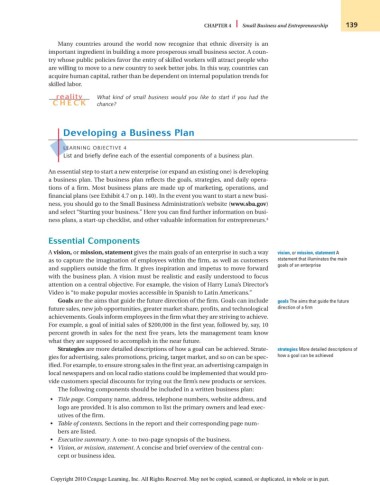Page 165 - Introduction to Business
P. 165
CHAPTER 4 Small Business and Entrepreneurship 139
Many countries around the world now recognize that ethnic diversity is an
important ingredient in building a more prosperous small business sector. A coun-
try whose public policies favor the entry of skilled workers will attract people who
are willing to move to a new country to seek better jobs. In this way, countries can
acquire human capital, rather than be dependent on internal population trends for
skilled labor.
reality What kind of small business would you like to start if you had the
CH ECK chance?
Developing a Business Plan
LEARNING OBJECTIVE 4
List and briefly define each of the essential components of a business plan.
An essential step to start a new enterprise (or expand an existing one) is developing
a business plan. The business plan reflects the goals, strategies, and daily opera-
tions of a firm. Most business plans are made up of marketing, operations, and
financial plans (see Exhibit 4.7 on p. 140). In the event you want to start a new busi-
ness, you should go to the Small Business Administration’s website (www.sba.gov)
and select “Starting your business.” Here you can find further information on busi-
ness plans, a start-up checklist, and other valuable information for entrepreneurs. 4
Essential Components
A vision, or mission, statement gives the main goals of an enterprise in such a way vision, or mission, statement A
as to capture the imagination of employees within the firm, as well as customers statement that illuminates the main
goals of an enterprise
and suppliers outside the firm. It gives inspiration and impetus to move forward
with the business plan. A vision must be realistic and easily understood to focus
attention on a central objective. For example, the vision of Harry Luna’s Director’s
Video is “to make popular movies accessible in Spanish to Latin Americans.”
Goals are the aims that guide the future direction of the firm. Goals can include goals The aims that guide the future
future sales, new job opportunities, greater market share, profits, and technological direction of a firm
achievements. Goals inform employees in the firm what they are striving to achieve.
For example, a goal of initial sales of $200,000 in the first year, followed by, say, 10
percent growth in sales for the next five years, lets the management team know
what they are supposed to accomplish in the near future.
Strategies are more detailed descriptions of how a goal can be achieved. Strate- strategies More detailed descriptions of
gies for advertising, sales promotions, pricing, target market, and so on can be spec- how a goal can be achieved
ified. For example, to ensure strong sales in the first year, an advertising campaign in
local newspapers and on local radio stations could be implemented that would pro-
vide customers special discounts for trying out the firm’s new products or services.
The following components should be included in a written business plan:
• Title page. Company name, address, telephone numbers, website address, and
logo are provided. It is also common to list the primary owners and lead exec-
utives of the firm.
• Table of contents. Sections in the report and their corresponding page num-
bers are listed.
• Executive summary. A one- to two-page synopsis of the business.
• Vision, or mission, statement. A concise and brief overview of the central con-
cept or business idea.
Copyright 2010 Cengage Learning, Inc. All Rights Reserved. May not be copied, scanned, or duplicated, in whole or in part.

